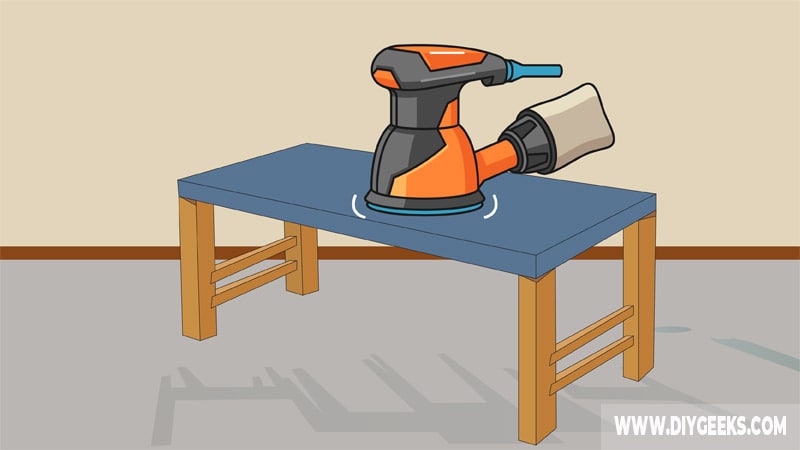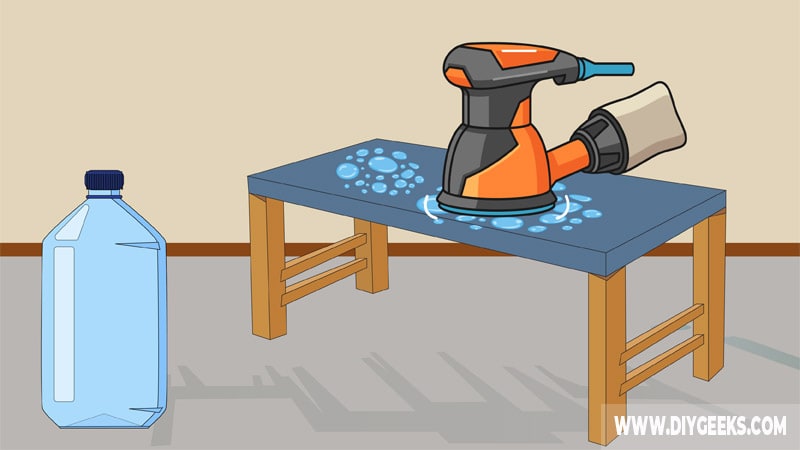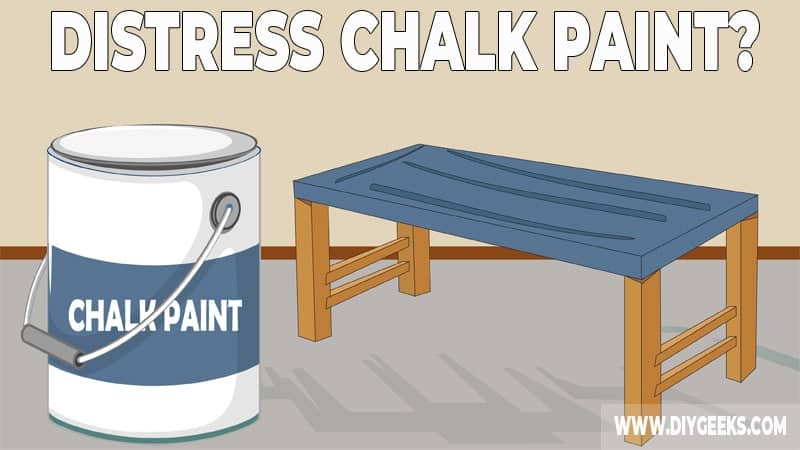A distressed chalk paint finish is perfect for old fittings and outdoor furniture, especially if you want a perfect antique look. So, how to distress furniture with chalk paint?
To distress chalk paint furniture, dry or wet sand random parts of the finish with extra fine-grit sandpaper (440-grit) until the finish gets an antique appearance.
You can use a sponge, brush, steel wool, or scrubbing pad instead of sandpaper to get a distressed finish.
What are The Benefits of Distressing Chalk Paint?
The benefits of distressing chalk paint are listed below.
- Distressing chalk paint hides imperfections, cracks, and holes in the furniture.
- It creates a vintage chalky paint finish.
- Increases Resale Value. Vintage (distressed) furniture costs more because of its vintage and old appearance.
- Gives Furniture a Different Look.
- It’s Easy to Do. Distressing furniture is easy as chalk paint has a matte and milky finish that is easy to sand.
Distress Furniture Before Wax vs After Applying Wax
Here’s a chart that shows the pros and cons of distressing furniture before or after waxing:
| Distressing Before Wax: | Distressing After Wax: |
|---|---|
| Less dust build-up. | Less dust. |
| It’s easier to wear through the paint to the wood. | Wax will prevent the sandpaper to wear (damage) the wood. |
| It’s easier. | It’s harder. |
| You can wet-distress. | You can’t wet-distress. |
| Can be done anytime | You must distress before the wax becomes hard. |
| The distressed finish won’t be even. Some parts will be more textured than others. | The finish will be even and consistent. |
Distressing chalk paint after wax gives you more control as the wax prevents the sandpaper from wearing through the finish too fast and prevents dust build-up.
Distressing chalk paint before wax produces more dust, but you can complete the project faster as you don’t need to wait for wax to dry.
You can wet or dry sand chalk paint without wax, but you can only dry sand chalk paint sealed with wax.
How To Distress Chalk Paint Furniture?
To distress chalk paint furniture, do the following things.
1. Dry Sand

Use extra fine-grit sandpaper (440-grit), sanding block, or power sander to dry sand chalk paint until the finish wears off on the edges of the furniture a bit. The rustic finish must look natural to make it look better and real.
To complete this project you need the following tools.
- Ultrafine-grit sandpaper
- Wax
- Paintbrushes
- Rags
- Safety Goggles.
While distressing the furniture wear safety goggles.
To distress chalk paint furniture with dry sanding, do the following things.
- Clean the Furniture. Clean the furniture to remove dust, stains, or grime that can prevent proper sanding.
- Apply Wax. It’s recommended to apply wax before distressing the chalk paint to prevent dust build-up and give the surface extra protection, according to Annie Sloan.
- Distress Chalk Paint. Rub extra fine-grit sandpaper (440-grit) against random areas on the furniture. To create a perfect vintage finish, the furniture must look naturally old. Sand on spots that take the most impact, such as table legs, door handles, etc.
- Inspect The Furniture. Inspect the furniture to see if you want to distress it more. Don’t apply too much pressure on the sandpaper and remove the paint as it’s easier to return to a spot and distress it more than to touch it up with another paint coat.
- Clean the Furniture – After you are done, use a lint-free cloth to clean it and apply polish, wax, or a topcoat if needed.
2. Wet Sand

Wet sanding is similar to dry sanding — the only difference is that you must use water and waterproof sandpaper while wet sanding.
To wet distress, use waterproof sandpaper (or sponge) to gradually wash the finish off on random areas of the furniture. Once the furniture dries, it will have a distressed (antique) finish.
The tools you need to complete this project are listed below.
- A bowl/bucket of water
- A soft sponge or waterproof sandpaper
- A pair of gloves
- Dry rags
To distress chalk paint furniture with wet sanding, do the following things.
- Clean the chalk paint finish.
- Dip an extra fine-grit waterproof sandpaper (440-grit) in a bowl of water and squeeze. The sandpaper must be damp, not wet.
- Use the dampened sandpaper to wash the finish off random surface parts.
- Wipe some off the water while sanding. Wet-distressing can be messy.
- Keep sanding the furniture until you achieve the distressed appearance you want.
- Leave the furniture to dry.
Can You Distress Furniture Without Sanding?
You can distress furniture without sanding by using a sponge, brush, steel wool, or scrubbing pad instead of sandpaper.
These items will wear off the chalk paint finish until the finish has a perfect antique appearance. But, you can wear off the chalk paint faster using any of these items.
Sanding is recommended because the ultrafine-grit sandpaper won’t wear off the finish of the wood. The ultrafine-grit sandpaper has small fine abrasives, so it’s difficult to wear through the paint to the wood.
Which Paints Can You Use to Distress Furniture?
The paints you can use to distress furniture are listed below.
Milk Paint
You can use milk paint to distress furniture. Milk paint is gotten from limes and pigments. Mix it with water and stir to form the paint and then apply it.
This paint is good for distressing because it is easy to sand, and the presence of lime (on its formula) gives the finish a perfect vintage look. Also, chalk paint and milk paint are similar.
Eggshell Paint
You can use eggshell paint to distress furniture because the paint texture is not glossy or matte. It has a flat texture making it easy to sand. It also dries quickly and sticks to furniture well.
Latex/Acrylic Paints
You can use latex or acrylic paint to distress a finish. But, it’s harder to distress them. They are water-based and have many pigments in their formula. This gives the perfect color contrast when distressed. Also, they are easy to sand.
On the other hand, you shouldn’t distress oil-based paint because they are glossy and hard when dry. As such, it’s hard to get a good distressed finish using them.


